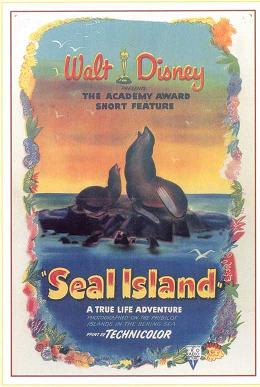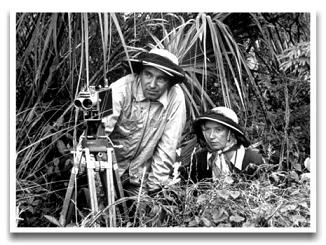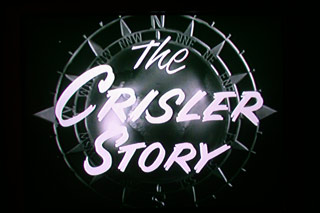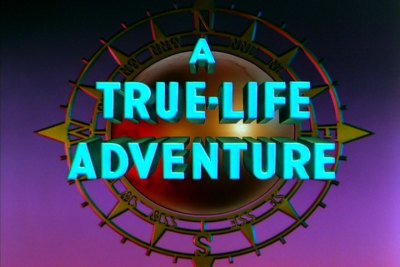February is Awards Season, and The Walt Disney Family Museum is celebrating with film presentations and visitor programs throughout the month. Screening this month in our museum’s state-of-the-art digital theatre is a collection of Walt’s award-winning True-Life Adventures films. Disney historian and author Jim Korkis has shared his excellent article about the people behind the cameras of this pioneering film series with Storyboard.
Walt Disney’s Love of Animals
In the December 1959 issue of Wisdom magazine, Walt Disney is quoted as saying: “Animals have personalities like people and must be studied. The spontaneity of the animal—you find it in small children, but it’s gradually trained out of them.”
Walt’s love and fascination with animals began with his childhood years on a farm in Marceline and led to his creation of a series showcasing animals and nature known as the True-Life Adventures.
Walt Disney’s True-Life Adventure Films
Walt made thirteen nature films in the 1950s known as the True-Life Adventures series. Eight of them won Academy Awards. They were shown in public schools for decades and some young people were even influenced into going into environmental careers due to seeing these films.
The Last Frontier Footage
The series began when Walt sent the husband-and-wife team of Alfred and Elma Milotte to film some footage of the last frontier, Alaska, in the hopes that viewing the footage would give him an idea of a story to share with audiences.
Studying reels and reels of unrelated shots, Walt’s attention was captured by footage of seals and asked the Milottes to emphasize the life of the seals but not show any indication of man’s presence. The resulting film became Seal Island. It won an Academy Award for Best Documentary and was one of the best of Walt Disney’s True-Life Adventure films.
An Appreciation for The Photographers
“I want to say how greatly I have come to respect the naturalist-photographers who are associated with us, both as scientists and as craftsmen. To observe them in action is an exhilarating lesson in resourcefulness, in patience, in knowledge applied to a particular problem, and in that devotion which few except the insatiably curious naturalist ever bring to a calling,” stated Walt Disney in the August 1954 issue of the magazine The Atlantic.
Teams of Two
There were 16 photographers on Water Birds, but many of the True-Life Adventure films were done by teams of two. Paul Kenworthy, Jr. and Robert H. Crandall shared camera credit on The Living Desert. Alfred and Elma Milotte were responsible not only for Seal Island, but Beaver Valley and Prowlers of the Everglades.

Another husband-and-wife team, Herb and Lois Crisler, are credited with The Arctic Wilderness, and the footage of the great elk migration in The Olympic Elk, and the bighorn sheep in The Vanishing Prairie. Cleveland Grant and his wife Ruth went deep into the Yukon territory of Canada to film bighorn sheep as well. Jack Couffer and Conrad Hall photographed sea elephants and giant sea turtles.
Stuart Jewell did the beautiful floral time-lapse photography and the cracking mud flats for The Living Desert. Jewell spent five days watching the section of drying earth for that time-lapse sequence.
Robert Crandall and his wife Francine filmed ants for Secrets of Life. At one point, Robert had to lie on his stomach for hours with his camera recording events beside an anthill while the angry ants nipped and stung him unmercifully.
Filming Close-Ups of the Animals
Crandall spent years studying different species of ants before getting the opportunity to film them for Disney series. Most of Crandall’s filming of ants was done with telephoto lenses outdoors with no disturbance of the insect colonies. Occasionally, he exposed various sections of the anthills to show the tunnels and underground activities.
For some of the extreme close-ups and bridging of scenes, individual ants and groups of ants were photographed on a specially built indoor table that was part of a fixed camera mount. It was still difficult to keep them within range and focal depth. Sometimes a close-up was so huge that a head or a leg filled the entire screen when projected in Technicolor on the theater screen.
It’s a Team Thing
“While the camera experts supply the spectacular elements on the screen, the True-Life Adventures are a team operation,” emphasized Walt in The Atlantic article, “Many creative minds have a share in their production. Before any expedition sets out, near or far, there are studio conferences, which may take weeks of study and decisions. Here we and our staff evaluate the proposed subject. Themes are suggested from preliminary research on the animal life of a given region. Time elements must be considered in line with production costs and exhibition dates. We exchange views and prospects with the naturalists. Science authorities are consulted.
“Organization of a project may start with just a broad idea. Such was the case when the Milottes went on the African safari to film the accurate, comprehensive life story of the African lion and the African elephant in equatorial Kenya and Tanganyika. They have been at it for almost three years. In the Dark Continent, they work alone; no porters or couriers on this camera safari; no luxury camp; no hunting with guns. At intervals they come into Nairobi to replenish food and fuel and to air-express their film trophies to the studio.”
Using Storytelling to Make The Animals Entertaining
Over the years, there has been some criticism over how Walt and his team presented this material including interpreting animal behavior in human terms. There was concern that through editing and narration, Walt was giving human qualities and attitudes to animals. Walt never meant these films to be simply a scientific documentation but to also be an entertainment to a mass audience, so he utilized his well-known story skills to emphasize personality. He realized that if people connected with a character, they would become invested in the story.

Making The Living Desert
Alfred and Elma Milotte on location for one of the best of Walt Disney’s True-Life Adventures, The African Lion. As Walt explained: “The little kangaroo rat was one of the most beguiling characters in The Living Desert. One in particular stood out in the picture—the one that kicked sand into the intruding viper’s eyes, then hastened home to save the babies from another snake. She was photographed at a distance of not over 15 feet in these successive scenes.
“The little mother and her fellow rodents completely ignored the cameramen. In the urge of elemental animal concerns, the greater fears transcend the lesser. And in this case the human begins were regarded as comparatively harmless.
“The cutaway section of the tunnels, through which the courageous mother carried her week-old babies in flight, was made of two separable sections. One was faced with glass. It was a natural tunnel and was kept dark and undisturbed while the young were born.
The King Snake
“When the king snake entered the far entrance, the removable section was lifted aside and the action was photographed at close range through the glass to show the exciting escape. Although this was of necessity a controlled scene, the action itself was according to nature’s own dictates, revealing a thrilling example of maternal devotion.
“In the kangaroo rat colony, we discovered a highly personalized individual: the one who kicked sand into the sidewinder’s eyes. Not only was she a resourceful sand-flinger; she was a precision artist who turned often to see if she was hitting the mark. No other member of the colony showed these same traits. In many of our True-Life ventures the camera teams come upon such individuals. Often they are natural comedians-in our eyes at least. They intrigue the photographers and contribute color to the action.”
Only The Best Film Made The Final Cut
All of the photographers used 16mm Kodachrome cameras. On average, for every 120,000 feet of 16mm film shot, perhaps only 30,000 feet were used in the final film. The Milottes spent three years getting footage for The African Lion, and only six percent of film they shot was used in the final 72-minute film.
The original negative was then processed to the standard 35mm for Technicolor projection in the theater. However, almost all of the equipment was modified. In fact, some of the modifications were so extreme that Walt Disney considered making his own cameras for the particular needs of the nature photographers.
For instance, modifications such as a quick focus adjustment mechanism, and lenses and emulsions adapted to meet variable conditions of natural light and range and fast enough to catch wild life on hoof and wing. Most importantly, telescopic lenses were needed to provide some minimal safety.
The Most High-quality Cameras
In The African Lion, the lioness that stalks and kills the wildebeest seemingly just a few feet beyond the camera was actually photographed 300 yards away…and downwind by the Milottes. The Crislers weren’t quite as fortunate when they moved their camera equipment within less than 100 yards of a grizzly bear family group feeding on a freshly killed caribou.
The Nearly Fatal Incident
The Crislers were downwind of the animals and the bears hadn’t sensed them. Crisler, engrossed in the filming, stood up to get better focus. Soon the animals were heading toward Herb Crisler and getting larger and larger in his viewfinder. Then the grizzlies disappeared momentarily and the Crislers decided to get out of there, but it was too late. The huge mother bear came out right in front of them around a projection. Her neck was arched and her ears flattened back.

The February 27, 1957 episode of the Disneyland TV program featured the story of the filmmaking Crislers. © DisneyCrisler grabbed up his tripod as his only weapon while his wife thumped a camera slide and lens cover together in a futile attempt to create a frightening noise. At that instant, the wind shifted and the bear caught the human scent and taken by surprise, turned and retreated, followed by the cubs.
This type of risk was common for the wildlife photographers employed on the True-Life Adventures. While filming The African Lion, the Milottes were attacked by a rhino they rescued from being stuck in the mud.
Nature as The Most Important Director
“Nature remains the director,” insisted Walt. “You can often set up your spying camera within a few yards of expected action. But only instinctive promptings, elemental urges, goad wild things to do what comes naturally. The cameraman must be ready for the moment of revelation; often he has to depend on luck as well as advance preparation. Many of nature’s finest and most exciting moments of action come with almost no warning. Wilderness creatures don’t pose for their portraits. They cannot be directed. Human presence, especially among the larger ones, is just one more menace in their fear-haunted lives. So the telescopic lens is a necessity in filming the more cautious, shy, or dangerous animals.
“We did not succumb to the alluring temptations to make villains or saints of the creatures portrayed in our films. We have maintained a sensitive regard for the wisdom of Nature’s design and have attempted to hold a mirror to the out-of-doors rather than to interpret it’s functioning by man’s standards.
“Our films have provided thrilling entertainment of educational quality and have played a major part in the worldwide increase in appreciation and understanding of nature. These films have demonstrated that facts can be as fascinating as fiction, truth as beguiling as myth, and have opened the eyes of young and old to the beauties of the outdoor world and aroused their desire to conserve priceless natural assets.”
Walt was certainly right about that because a half a century later, these films are still effective thanks to Walt’s keen storytelling (aided by such Disney legends as James Algar, Winston Hibler and Ben Sharpsteen), the evocative music (primarily by Paul Smith) and the amazing visuals by those self-sacrificing and long-suffering nature photographers who captured moments that had never before been filmed.
Visit Us and Learn More About Disney’s Amazing History
Originally constructed in 1897 as an Army barracks, our iconic building transformed into The Walt Disney Family Museum more than a century later, and today houses some of the most interesting and fun museum exhibitions in the US. Explore the life story of the man behind the brand—Walt Disney. You’ll love the iconic Golden Gate Bridge views and our interactive exhibitions here in San Francisco. You can learn more about visiting us here.
© Jim Korkis, all rights reserved. Published with permission.
Jim Korkis is an internationally-respected Disney Historian who has written hundreds of article and done hundreds of presentations on all things Disney for more than thirty years. He is the author of the acclaimed new book The Vault of Walt. His extensive expertise and knowledge, particularly in previously-unexplored areas of Disney history, has been utilized by many other researchers as well as The Walt Disney Company.
The Vault of Walt is a highly-praised recently-published book featuring more than 450 pages of previously untold stories about Walt Disney, the Disney theme parks, and the Disney films as well as many out-of-the-ordinary and forgotten stories of Disney history.
On Saturday February 25 at 3:00pm, the special program Walt Disney’s Worlds of Nature will feature Academy Award-nominated producer Don Hahn (Beauty and the Beast, The Little Matchgirl) and a presentation about Walt’s pioneering and frequently-emulated True-Life Adventures films, and showing the relationship between that series and the acclaimed Disneynature documentaries (Earth, Oceans,African Cats, and the upcoming Chimpanzees) for which Hahn serves as executive producer. (Separate admission required.
Film programs through February change weekly, with screenings daily at 1:00pm and 4:00pm (except Tuesdays, and February 18, 25 and 26). Further program information and tickets are available at the Reception and Member Service Desk at the Museum, or online by clicking here.
*Images from top to bottom: 1) The globe from this famous logo is on display in Gallery 8 © Disney. 2) Seal Island poster art. 3) Alfred and Elma Milotte on location for The African Lion. 4) The February 27, 1957 episode of the Disneyland TV program featured the story of the filmmaking Crislers. © Disney

